If, like me, you’ve been looking for a nice guide to illustrated manuscripts in the Universitätsbibliothek Heidelberg’s Cod. Pal. Germ. collection for a while, you’re in for a bit of a treat here. 🙂
German librarian / book historian Hans Wegener’s (1927) “Beschreibendes Verzeichnis der deutschen Bilder-Handschriften des späten Mittelalters in der Heidelberger Universitäts-Bibliothek” (which you can download from UB Heidelberg here) runs through a (mostly) chronological series of illustrated manuscripts from the library, discussing each one’s writer(s) and (usually unnamed) illustrator(s).
(For reference, the para at the top of its p.10 was where Hans Wegener asserted that the illustrator of Cod. Pal. Germ. 530 also drew the pictures for Staatsbibliothek Eichstätt MS 212, as I mentioned in my last post.)
The easiest way to view all the illustrations is to use UB Heidelberg’s HeidICON tool (there’s a link on the left of each CPG page). There, you can jump straight to a grid of illustrations in that manuscript, i.e. clicking on a thumbnail brings up the full-size picture on the right-hand side.
I went through all the drawings from 1400 to about 1470, and have pasted in some of the most interesting drawings. Enjoy!
1300 to 1400 (for completists only)
Cod. Pal. Germ. 164 – Sächsisches Lehnrecht, Obersächsische Hs., Um 1320
Cod. Pal. Germ. 167 – Landrecht des Sachsenspiegels und des Schwabenspiegels. Niederdeutsche Hs. Hälfte XIV. Jahrh.
Cod. Pal. Germ. 341 – Sammlung kleinerer Gedichte. Oberdeutsche Hs. Mitte XIV. Jahrh.
Cod. Pal. Germ. 53 – Schwabenspiegel. Oberdeutsche Hs. Ende XIV. Jahrh.
1400 (Various)
Cod. Pal. Germ. 329 – Hugo von Montfort: Gedichte und Lieder. [Bayrische Hs. Um 1400.] (just initials)
Cod. Pal. Germ. 14 – H. von Mügeln: „Der meide kränz”. [Bayrische Hs, 1407.] (just initials)
Cod. Pal. Germ. 336 – Enenkels Weltchronik. [Bayrische Hs, Um 1410.]
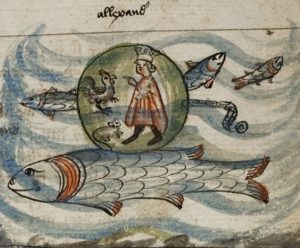
Cod. Pal. Germ. 5 – Wahrsagebuch. [Mitteldeutsche, wohl rheinfränkische Hs, 1400-1420. (Just one drawing)
Cod. Pal. Germ. 330 – Thomasin von Zirklaere: Wälscher Gast. [Bayrische Hs, 1410-1420.]
I discussed cpg330 in this recent post, but it has other interesting images (note that HeidICON has no entries for this!):
Cod. Pal. Germ. 794 – Boner: Edelstein. [Bayrische Hs. 1410-1420]
Die elsässische Werkstatt von 1418.
Before Diebold Lauber’s famous workshop, there was another (unnamed) workshop in Alsace, usually referred to as the Werkstatt von 1418.
Cod. Pal. Germ. 27 – Otto von Passau: Vierundzwanzig Alte. [Elsässische Werkstatt von 1418. 1418.]
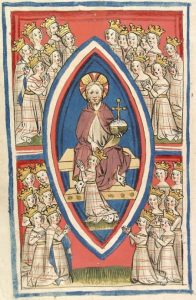
Cod. Pal. Germ. 144 – Heiligenleben. [Elsässische Werkstatt von 1418.] (Lots of saints being killed, if you like that kind of thing.)
Cod. Pal. Germ. 403 – Heinrich von Veldeke: Eneide. [Elsässische Werkstatt von 1418.]
Cod. Pal. Germ. 371 – Lanzelot. [Elsässische Werkstatt von 1418. 1420.] (only two images at the front)
Cod. Pal. Germ. 365 – Ortnit. [Elsässische Werkstatt von 1418. 1420.] (Only two drawings)
Cod. Pal. Germ. 323 – Rudolph von Ems: Wilhelm von Orlenz. [Elsässische Werkstatt von 1418. 1420]
Cod. Pal. Germ. 359 – Rosengarten und Lucidarius. [Elsässische Werkstatt von 1418. Um 1420.] (Not particularly interesting drawings)
Other Stuff
Cod. Pal. Germ. 432 – Speculum humanae salvationis. [Mittelrheinische Hs. 1420-1430.]
Cod. Pal. Germ. 471 – Hugo von Trimberg: Renner. [Bayrische Hs, 1431.]
Cod. Pal. Germ. 148 – Biblia pauperum [ Bayrische Hs, 1430-1440] und Brevier [Bayrische, wohl Eichstätter Hs, Um 1450]
Cod. Pal. Germ. 7 – Wahrsagebuch [Bayrische Hs, 1430-1440]
Die Werkstatt des Diebolt Lauber in Hagenau.
I have, of course, discussed Diebold Lauber’s workshop a good number of times before. And UB Heidelberg has plenty of Lauber mss!
Cod. Pal. Germ. 362 – Flore und Blancheflor [Werkstatt des Diebolt Lauber in Hagenau, 1430-1440]
Cod. Pal. Germ. 324 – Dietrich und seine Gesellen. [Werkstatt des Diebolt Lauber in Hagenau, Um 1440]
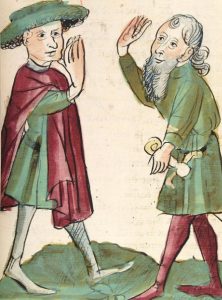
(The next five items form “Deutsche Bibel in 5 Bänden”.)
Cod. Pal. Germ. 19 – Die Bücher Mose, Josua und Richter [Werkstatt des Diebolt Lauber in Hagenau, Um 1440] (not very interesting drawings)
Cod. Pal. Germ. 20 – Bücher der Könige und Paralipomenon I und IL [Werkstatt des Diebolt Lauber in Hagenau, Um 1440] (also not very interesting drawings)
Cod. Pal. Germ. 21 – Die Bücher Esra, Nehemia, Tobias, Judith, Esther, Hiob, Psalter, Parabole Ecclesiastes, Cantica, Sapientia und Ecclesiasticus. [Werkstatt des Diebolt Lauber in Hagenau, Um 1440] (again, pretty dull)
Cod. Pal. Germ. 22 – Die Bücher jesaia, Jercmia, Baiiieli, Hesekiel, Daniel und die zwölf kleinen Propheten. [Werkstatt des Diebolt Lauber in Hagenau, Um 1440] (didn’t work for me at all)
Cod. Pal. Germ. 23 – Das Neue Testament [Werkstatt des Diebolt Lauber in Hagenau, Um 1440] (nope, the whole set failed to press my buttons)
Cod. Pal. Germ. 300 – Megenberg: Buch der Natur. [Werkstatt des Diebolt Lauber in Hagenau, 1440-1450]
Cpg300 contains an old pair of friends, but some other stuff too:
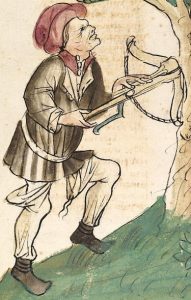

Cod. Pal. Germ. 149 – Sieben weise Meister und die Chronik des Martin von Polen. [Werkstatt des Diebolt Lauber in Hagenau, Um 1450]
Cod. Pal. Germ. 339 – Parzival. [Werkstatt des Diebolt Lauber in Hagenau, Um 1450]
Cod. Pal. Germ. 137 – Martin von Polen: Chronik. [Werkstatt des Diebolt Lauber in Hagenau, Um 1460] (dull as ditchwater, unless you really like grinding your way through endless unconvincing drawings of popes)
More Other Stuff
Cod. Pal. Germ. 311 – Megenberg: Buch der Natur [Mittelrhemische Hs, 1450-1460] (Has a nice catoblepas)
Cod. Pal. Germ. 438 – Gedieht von den zehn Geboten, der Bulie, der Beichte und den sieben Todsünden. [Mitteldeutsche Hs., 1450-1460]
Cod. Pal. Germ. 314 – Boner: Edelstein. [Augsburger Hs, Um 1445]
Cod. Pal. Germ. 322 – Otto von Passau: Vierundzwanzig Alte. [Oberrheinische Hs, 1457]
Cod. Pal. Germ. 644 – Medizinische Traktate [Oberdeutsche Hs, 1450-1460] (Thirty pictures of physicians looking at flasks of urine. Nice.)
Cod. Pal. Germ. 4 – Rudolf von Ems: Wilhelm von Orlens [Augsburger Hs, 1458]
Cod. Pal. Germ. 147 – Lanzelot [Mitteldeutsche Hs., Mitte XV. Jahrhundert]
Cod. Pal. Germ. 344 – Gedichte (“Von dem Eilenden Buoben”, Spruchgedicht von der Minne und dem Pfennig und Spruchgedicht vom Streite
zweier Frauen über Liebe und Leid der Minne) [Oberrheinische Hs, Um 1459]
Cod. Pal. Germ. 60 – Deutsche Bibel, Brief des Juden Samuel, Ars moriendi. Legende des hl. Patricius und die Legende des hl. Brandon. [Oberdeutsche Hs, Um 1460]
Cod. Pal. Germ. 86 – Boner: Edelstein. [Bayrische Hs, 1461]
Sal. VII. 114. Belial [Oberdeutsche Hs, Um 1460]
Cod. Pal. Germ. 346 – Tristan [Seeschwäbische Hs., Um 1460]
Cod. Pal. Germ. 463 – Jakob von Cessolis: Schachzabel [Oberschwäbische Hs., 1463]
Cod. Pal. Germ. 795 – Belial [Oberdeutsche, wohl Augsburger Hs, Um 1470]
Cod. Pal. Germ. 320 – Thomasin von Zirklaere: Walscher Gast [Schwäbische Hs, Um 1470]
Cod. Pal. Germ. 646 – Passion. [Oberdeutsche, wohl Augsburger Hs. 1470]
Cod. Pal. Germ. 76 – Ackermann von Böhmen [Schwäbische Hs. Um 1470]
Cod. Pal. Germ. 111 – Legende vom hl. Mauritius und Legende vom hl. Meinrat. [Schwäbische Hs., Um 1470]
Hans Wegener continues his book with CPG manuscripts from Ludwig Hennfflin’s Werkstatt, but this is now well out of our window of interest, so I’ll stop here. 🙂
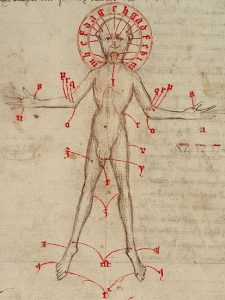

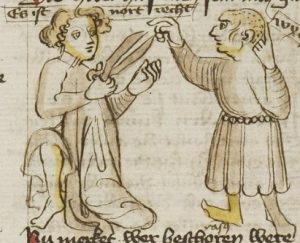
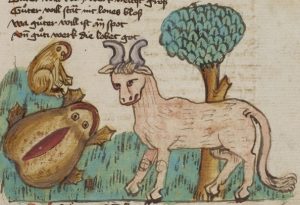
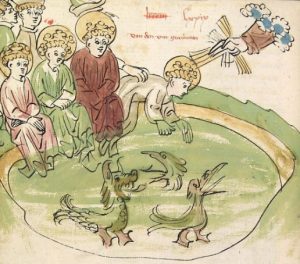

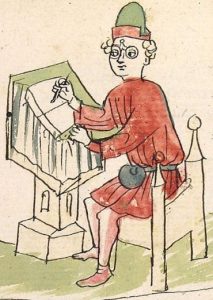
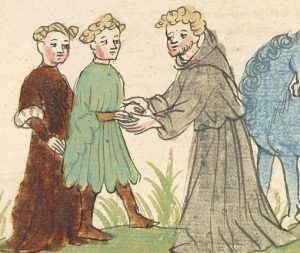




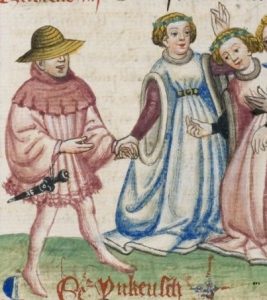
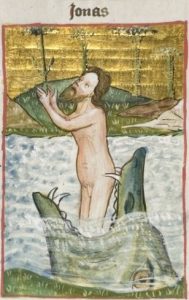


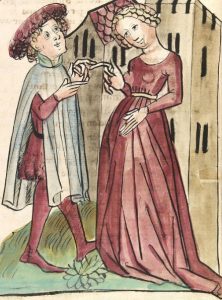
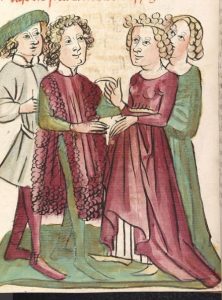
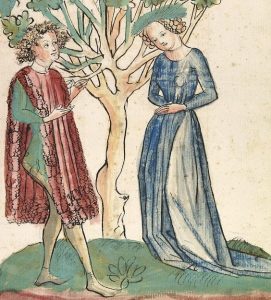
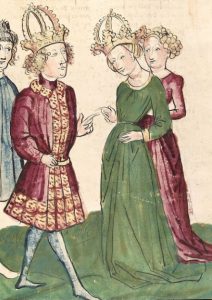
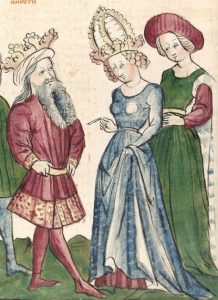

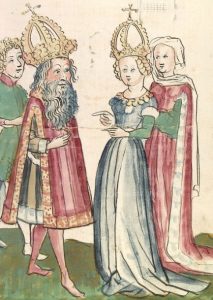
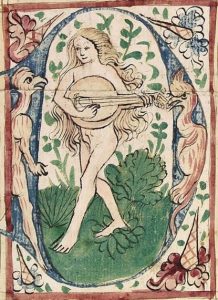

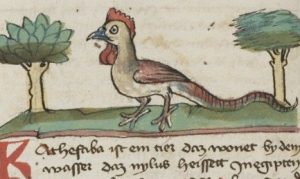
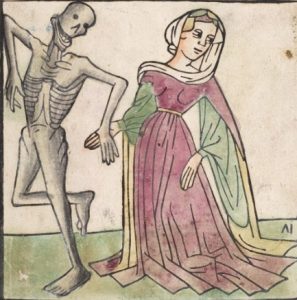

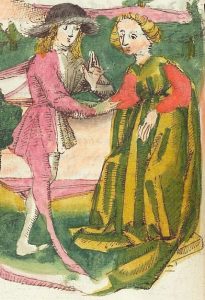
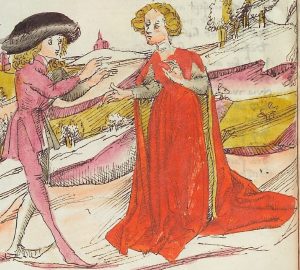

Nick, the Alexander chicken-bubble is a diving bell.
Quite a few manuscripts include this intriguing image (in various ways). I’ve also come across images of a guy underwater breathing through a straw. 🙂
Great post, Nick, I will definitely use this when my research takes me to these parts again.
It really takes going through some Alsatian Mss yourself to appreciate how they handle their images.
A small note on Jonah: when he goes in head first, he is indeed being swallowed by the whale. But when he is standing in the whale’s mouth, he is re-emerging. This is why he is usually shown praying (orans pose); it is his continuing faith in God that saved him.
Koen: thanks for that note on Jonah, I included the images (of course) because of the nymph and the fish on f79v.
What I gained from Hans Wegener’s book (and tried to get across in the post) was more of a high-level chronological view of 15th century German illustrated manuscripts – previously, I had tended to view manuscripts thematically, which obscured the bigger picture.
Now I feel much more comfortable in saying that I strongly suspect that the Voynich’s zodiac roundel drawings were derived from an Alsace manuscript (probably a calendar), and that the source of a fair few of the other drawings was ultimately Bavarian manuscripts. But even so (and notwithstanding the radiocarbon dating), I would feel extraordinarily uncomfortable placing the creation of the Voynich Manuscript itself to the 1420s or even the 1430s – things like the elaborate albarelli in the pharma section still seem well out of scope for the illustrators I’ve seen.
But maybe I need to look at lots more 15th century German illustrated manuscripts to broaden my mind yet further. 🙂
I think it’s likely that the VM draws from a number of more-or-less contemporary manuscripts, probably a library. Manuscripts were often made as gifts for relatives or diplomatic connections, and copies ended up at different courts.
So they don’t all have to be German. There is most definitely some Balneis in there, for example. My impression is that someone (without the confidence to draw from memory) hunted through whatever examples were available to him in order to compose the VM. It’s a bit similar to the way the Alsatian workshops used creative copying.
Lovely images of fifteenth-century Germany, Nick. Everyone looks so warm and comfortable, and none but the dead, the dabbler and the allegorical figure are ever shown unshod in the post-1440 printed books.
All the best in these troubled times to you Nick and to your readers.
Koen: there’s French too. So yes, we’re talking about a library containing manuscripts from all over Europe.
Was this a monastic library? Personally, I don’t think so, though I do believe it travelled to Bohemia via at least one Swiss monastic library.
As far as confidence goes, Mary D’Imperio wrote that she thought it was a manuscript drawn by someone primarily used to making technical drawings, and there’s certainly something of the jackdaw’s nest to its styling. 🙂
I’m also not primarily thinking about a monastic library. Rather some wealthy person’s collection. Although I must say I have not yet studied the various types of medieval libraries and their typical extent and content.
Are you aware of any efforts to link possible VM sources to known historical collections?
Koen: the only actual source book that has been specific enough to trace (and I tried) is Nicole Oresme’s Livre du Ciel et du Monde, but even that connection is still very far from certain.
I suspect that the herbal page with two horse-like things in the roots will turn out to be a machine drawing that had been derived from Taccola’s winch drawing, but there were plenty of copies of that made during the 15th century, so that’s no use for library tracing.
Years ago, I wondered about the Visconti library in Pavia. For one thing, it is generally believed that the Paris MS of the Tractatus de Herbis (the ‘Manfredus’ herbal MS 6823) was there in the 1420’s. This may have been a source of inspiration for the “oak and ivy” drawing in the Voynich MS.
Now that’s several uncertainties already. For one, Toresella strongly doubts that the MS in the Visconti catalogue and the Paris MS are one and the same, and he has some good points. The main issue is that the Visconti catalogue describes the MS as “on paper”. However, the majority of this library ended up in Paris, so one can’t be sure either way.
The Visconti library was open to visitors, so that’s also interesting. (Chaucer is one of the known visitors).
I wanted to find out if this library also had a copy of the ‘Balneis’, which I would consider a good sign. However, the catalogues do not list any. I’m not too optimistic about this possibility anymore. Also, we don’t know how many other copies of the Tractatus existed and are now lost. If the Visconti MS was really on paper, where is it now?
Two of the well-known Balneis MS’s were in the library of Alpfonso V of Aragon, in Naples, but that was after the time the Voynich MS was written. Who knows where they were before.
Hi Nick.
….herbal page with two horse-like things in the roots….
what party is it ? MS 408 ?
Thank you.
http://ciphermysteries.com/wp-content/uploads/sites/6/2018/10/voynich-horse-hoist-2.jpg
Nick. unfortunately, there is not written about the machine. it says about love. and John II. of Rosenberg. and his birth. and the anniversary of his birth. that´s 5 May. the whole plant is the tree of life. with its fruits. children. important are numbers 4 and 6. sons and daughters. the flower symbolizes 5 May. number 3 symbolizes the birth of John, whon was born as 3 in the order of his father Oldřich II. of Rosenberg.
Nick: Just wondering the extent to which we can say manuscripts circulated from region to region. Did Italian works/manuscripts often make their way to Germanic regions and vice-versa? So what I am wondering is the extent to which the market for texts in the early pre-printing era was international I.e. European or very much regional. More specifically can we say much about where someone viewed a manuscript on the basis of where the manuscript originated?
Mark Knowles: “Did Italian works/manuscripts often make their way to Germanic regions and vice-versa?”
Yes. Northern Italy (Lombardy) was part of the Holy Roman Empire. Many Lombardic manuscripts are in Heidelberg and Munich repositories.
Also, university students traveled extensively. They would frequently earn their undergraduate degree at one university and their graduate degree at another. As an example, many medical students started in England and Germany and finished in France and southern Italy.
JKP: Then the implications of that it seems to me are that we can say much less definitively about the place of origin of the Voynich. If we have imagery that is found in Italian, German or French manuscripts then it is quite possible that the author saw those manuscript, but not in the place of origin.
It is often asserted that there are drawings similar to those in German manuscripts and therefore it must have links to Germanic regions, but it could be possible that the author was in Rome and just saw manuscripts from many other regions, but never left Rome.
Now my own theory is one where the author was in Italy and German and French parts of Switzerland.
Nevertheless do we see the same style of manuscript distributed throughout central Europe or do we see regional distinctions?
If we can associate the sources with the geographical origins of the manuscript then we can say something about geographical origjns of the manuscript given what we know about the geographical origins of the sources. This often tends to be assumed to be the case by Voynich researchers, but is that a mistaken assumption?
This is why I spent years tracing the origin and migration of the zodiac-figure symbols.
I’ve written all this before in my blogs, but the VMS belongs to a specific subset that appears to have begun in northern France/Flanders in the early medieval period and migrated gradually to north-central Germany and the Alsace over a couple of centuries, and from there to other parts of Germany and Austria (Bavaria and Tyrol) and northern Italy.
Unfortunately, this does not tell us whether the VMS creator saw old versions from France, middle versions from the Alsace or north-central Germany (the parts with Flemish influence), or newer versions from Bavaria and Italy, but at least it confirms that this zodiac tradition does exist, and that the VMS zodiac-figures are not out-liers, but have been influenced by a specific tradition.